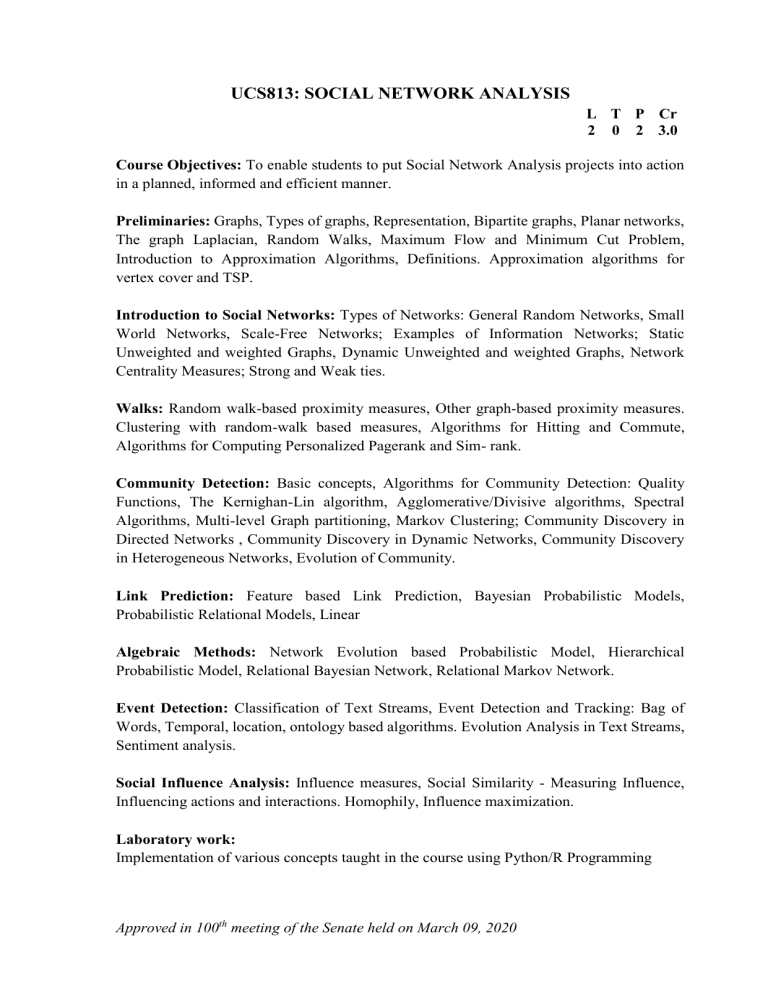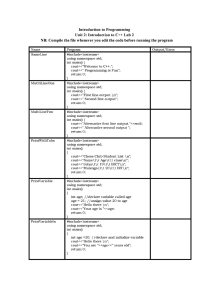
UCS813: SOCIAL NETWORK ANALYSIS L T P Cr 2 0 2 3.0 Course Objectives: To enable students to put Social Network Analysis projects into action in a planned, informed and efficient manner. Preliminaries: Graphs, Types of graphs, Representation, Bipartite graphs, Planar networks, The graph Laplacian, Random Walks, Maximum Flow and Minimum Cut Problem, Introduction to Approximation Algorithms, Definitions. Approximation algorithms for vertex cover and TSP. Introduction to Social Networks: Types of Networks: General Random Networks, Small World Networks, Scale-Free Networks; Examples of Information Networks; Static Unweighted and weighted Graphs, Dynamic Unweighted and weighted Graphs, Network Centrality Measures; Strong and Weak ties. Walks: Random walk-based proximity measures, Other graph-based proximity measures. Clustering with random-walk based measures, Algorithms for Hitting and Commute, Algorithms for Computing Personalized Pagerank and Sim- rank. Community Detection: Basic concepts, Algorithms for Community Detection: Quality Functions, The Kernighan-Lin algorithm, Agglomerative/Divisive algorithms, Spectral Algorithms, Multi-level Graph partitioning, Markov Clustering; Community Discovery in Directed Networks , Community Discovery in Dynamic Networks, Community Discovery in Heterogeneous Networks, Evolution of Community. Link Prediction: Feature based Link Prediction, Bayesian Probabilistic Models, Probabilistic Relational Models, Linear Algebraic Methods: Network Evolution based Probabilistic Model, Hierarchical Probabilistic Model, Relational Bayesian Network, Relational Markov Network. Event Detection: Classification of Text Streams, Event Detection and Tracking: Bag of Words, Temporal, location, ontology based algorithms. Evolution Analysis in Text Streams, Sentiment analysis. Social Influence Analysis: Influence measures, Social Similarity - Measuring Influence, Influencing actions and interactions. Homophily, Influence maximization. Laboratory work: Implementation of various concepts taught in the course using Python/R Programming Approved in 100th meeting of the Senate held on March 09, 2020 Text Books / Reference Books: 1. Charu C. Aggarwal, Social Network Data Analytics, Springer; 2011. 2. S.Wasserman, K.Faust: Social Network Analysis: Methods and Applications, Cambridge Univ Press, 1994 3. Scott, J. (2007). Social network analysis: A handbook (2nd Ed.). Newbury Park, CA: Sage. 4. Knoke (2008). Social Network Analysis, (2nd Ed). Sage. Course Learning Outcomes (CLOs) / Course Objectives (COs): After the completion of the course, the student will be able to: 1. Formalize different types of entities and relationships as nodes and edges and represent this information as relational data. 2. Plan and execute network analytical computations. 3. Use advanced network analysis software to generate visualizations and perform empirical investigations of network data. 4. Interpret and synthesize the meaning of the results with respect to a question, goal, or task. 5. Collect network data in different ways and from different sources while adhering to legal standards and ethics standards. Approved in 100th meeting of the Senate held on March 09, 2020

